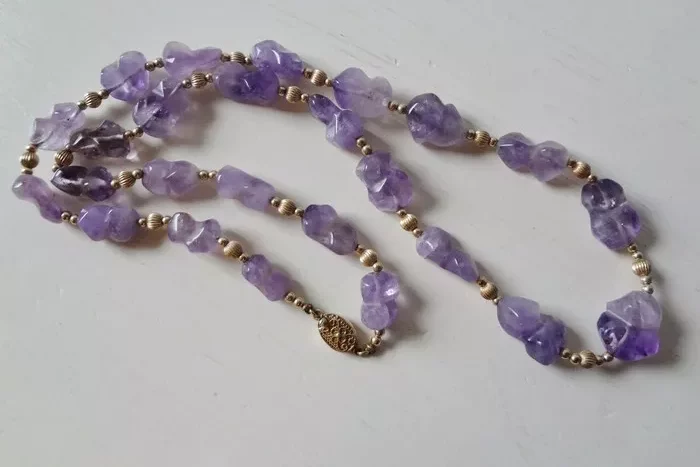Amethyst, a gemstone known for its captivating purple hues, has fascinated people for centuries. Its name, derived from the Greek word “améthystos,” meaning “not intoxicated,” hints at its ancient legends and cultural significance. But when did amethyst come out into the public eye, and how has its popularity evolved over time? Let’s delve into the history, characteristics, cultural meanings, and modern applications of this stunning gemstone.
The Discovery and Early Uses of Amethyst
The exact timeline of amethyst’s discovery is uncertain, but it has been cherished for thousands of years. Early civilizations, including those in Greece and Rome, valued amethyst for its beauty and believed it possessed mystical properties. The Greeks, in particular, associated amethyst with the god Bacchus, the god of wine, and believed it could prevent intoxication. This led to amethyst being worn as protective amulets by soldiers and sailors, who sought clarity and composure in battle and at sea.
Historical Significance and Legends
In ancient times, amethyst was believed to possess a range of magical and healing properties. It was thought to protect against evil spirits, enhance wisdom, and promote sobriety. The legend of amethyst’s origin is rooted in Greek mythology. According to one tale, Bacchus, the god of wine, was angered when a mortal named Amethyst rejected his advances. In his fury, he vowed to turn her into a white maiden forever. However, Amethyst’s love, a humble shepherd named Dionysius, intervened and pleaded for her life. As a compromise, Bacchus transformed Amethyst into a clear, crystalline stone, but his tears of wine stained it purple, creating the gemstone we know today.
Geological and Mineralogical Characteristics
Amethyst belongs to the quartz family and is a variety of silicon dioxide. Its purple color is due to trace amounts of iron and manganese impurities within the mineral’s crystalline structure. The intensity and shade of purple can vary widely, ranging from deep violet to light lavender, depending on the mineral composition and the conditions under which it formed.
Geologically, amethyst is often found in igneous and metamorphic rocks, particularly in pegmatites and hydrothermal veins. Some of the most famous amethyst deposits are located in Brazil, Uruguay, Zambia, and Sri Lanka. The quality of amethyst can vary greatly, with the most valuable pieces exhibiting a strong, vivid purple color with no visible color zoning or inclusions.
Cultural and Symbolic Meanings
Across various cultures, amethyst has been symbolically linked to spirituality, tranquility, and protection. In ancient Egypt, it was believed to represent the goddess Ma’at, the personification of truth, harmony, and balance. The Hebrews associated amethyst with the tribe of Simeon, and in Christian tradition, it is one of the twelve stones on the breastplate of the high priest, symbolizing one of the twelve tribes of Israel.
In modern times, amethyst remains a popular gemstone for jewelry and spiritual use. Its calming purple hues are often associated with peace, serenity, and spiritual awareness. Many people believe that wearing amethyst can enhance their emotional well-being, promote clarity of thought, and provide protection against negative energies.
Modern Applications and Popularity
Today, amethyst is widely used in jewelry, including rings, necklaces, earrings, and bracelets. Its versatility allows it to be set in gold, silver, and other precious metals, making it a favorite among jewelers and gemstone enthusiasts. High-quality amethyst can fetch high prices, especially when cut and polished to showcase its vibrant color and clarity.
In addition to its use in jewelry, amethyst is also popular in crystal healing and metaphysical practices. Many believe that amethyst can balance the chakras, promote spiritual growth, and enhance emotional well-being. Its calming energy is thought to be particularly beneficial for those struggling with anxiety, stress, or insomnia.
The Evolution of Amethyst’s Popularity
The popularity of amethyst has fluctuated over time. In ancient times, it was highly valued and often reserved for royalty and the elite. However, as mining techniques improved and new deposits were discovered, amethyst became more accessible to the masses. By the 19th century, Brazil’s discovery of large amethyst deposits significantly increased the gemstone’s availability, making it more affordable and widely used in jewelry.
Despite its increased availability, amethyst remains a cherished gemstone. Its unique purple hues and cultural significance continue to attract collectors and jewelry lovers worldwide. In recent years, there has been a resurgence in interest in crystal healing and metaphysical practices, further boosting amethyst’s popularity.
Quality Factors and Care
When evaluating the quality of amethyst, several factors are considered. Color is the most important, with vivid, even purple hues being the most valuable. Clarity is also important, as fewer inclusions and better transparency enhance the gemstone’s appearance. Cut and carat weight also play a role in determining amethyst’s value.
To maintain amethyst’s beauty and value, proper care is essential. Amethyst is a relatively hard gemstone, with a Mohs hardness of 7, but it can still scratch or break if subjected to rough handling. It’s best to store amethyst in a fabric-lined jewelry box or pouch to prevent scratching. When cleaning, use a soft cloth and warm water, avoiding harsh chemicals or abrasives that could damage the gemstone’s surface.
Conclusion
In summary, amethyst has a rich history and cultural significance dating back thousands of years. Its captivating purple hues, mystical legends, and versatile applications have made it a cherished gemstone worldwide. From ancient times to the present day, amethyst has evolved from being a rare and precious gem reserved for royalty to a widely available and popular gemstone used in jewelry and spiritual practices.
Related topic:


